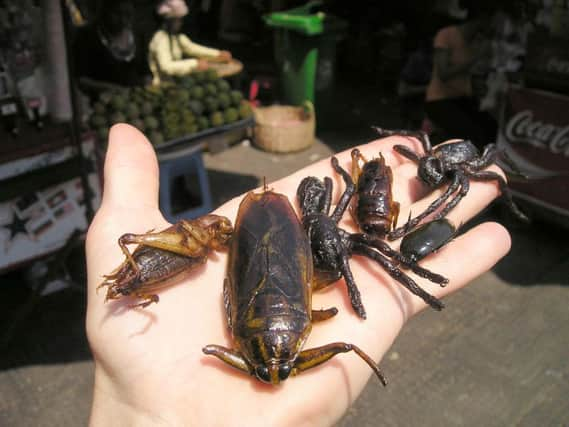Bugs - The ready meal solution to solve threat of global food shortage?


The ballooning world population and global warming has led to fears of a potential food shortage by the middle of the century.
Simon Forrester, chief executive of the British Pest Control Association (BPCA), is convinced the consumption of insects (or entomophagy) - already common in many parts of the world - could provide the solution in the UK too.
Advertisement
Hide AdAdvertisement
Hide AdHe said: “One of the greatest food security challenges we face is the sustainable production of animal protein.
“Meat, eggs, dairy products and fish have a very high resource cost per kilo and, with the world population set to exceed nine billion by 2050, production will need to increase by as much as 73 per cent to satisfy demand.
“Amid the threat of global warming and many other demands on our resources, ‘meat’ as we know it is likely to become more of a luxury and, as demand for protein grows, the price will increase.
“But the answer could, almost literally, be right under our feet. Insects make up more than 80 per cent of all animal species and, as there are an estimated 200 million to two billion insects per human, there’s a wide range of potential menu items.”
Advertisement
Hide AdAdvertisement
Hide AdThe UN Food and Agriculture Organisation has said that eating insects is generally healthier than eating meat. It could also boost nutrition and reduce pollution.
Crickets and locusts, for example, are packed with essential amino acids, vitamins and minerals. Others, such as beetles, are a good source of polyunsaturated (good) fatty acids.
So much for the science. The problem, as Mr Forrester readily admits, will be selling the idea to the average man or woman in the street.
He added: “Insects are a great source of protein and some vegetarians already see eating them as perfectly acceptable.
Advertisement
Hide AdAdvertisement
Hide Ad“Yet most people in this country would be put off by the prospect and that social aversion is something of a sticking point.
“The idea of tucking in to a plate full of bugs seems far from attractive at the moment, but diets can change rapidly as the growth of delicacies such as lobster, oysters or snails – all of which area pretty odd to look at - has shown.
“Nobody is suggesting we grab handfuls of cockroaches from behind the fridge and tuck in – they’re a little too ‘free range’ to be eaten without health consequences.
“Insects produced for human consumption must come from reliable sources, as must their feed, and both must pass the same stringent conditions as any other foodstuff.
Advertisement
Hide AdAdvertisement
Hide Ad“But many insects and other species currently regarded as pests could easily become part of our diet. It might take a few years, but it is likely to be just a question of time.”
Bugs are already a staple part of the diet in many parts of the world and UN research has revealed that more than two billion people in Asia, Africa, Central and South America are happily tucking in.
Insect-breeding facilities are now springing up across Europe as the idea begins to catch on.